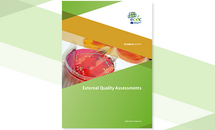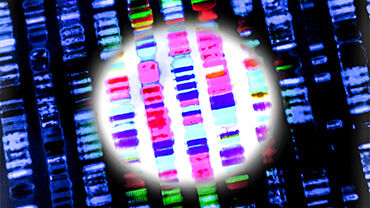Ninth external quality assessment scheme for Salmonella typing
ECDC is supporting a large number of targeted External Quality Assessment (EQA) schemes with voluntary participation by reference or primary laboratories, which are active members of EU surveillance networks. The rationale for these EQAs is to underpin the capability and reliability of infectious disease case detection and confirmation or agent characterisation as used for data reporting to EU surveillance and alert systems.
Executive summary
This report presents the results of the ninth round of the external quality assessment (EQA-9) scheme for typing of Salmonella enterica subsp. enterica organised for public health national reference laboratories (PH NRLs) in ECDC’s Food- and Waterborne Diseases and Zoonoses network (FWD-Net). Since 2012, the EQA scheme has covered molecular typing methods used for EU-wide surveillance. The EQA-9 scheme was arranged by the Section for Foodborne Infections at the Statens Serum Institut (SSI) in Denmark.
Salmonellosis was the second-most commonly reported zoonotic disease in EU in 2017, with a notification rate of 19.7 cases per 100 000 population. From 2008 to 2017, a decreasing trend of confirmed salmonellosis cases was observed for 25 countries that consistently reported during the period. However, during the last five years (2013– 2017), the overall EU/EEA trend did not show any significant increase or decrease. Since 2007, ECDC's Food and Waterborne Diseases and Zoonoses programme has been responsible for EU-wide surveillance of salmonellosis, including facilitating the detection and investigation of food-borne outbreaks. Surveillance data, including certain basic typing parameters, are reported by Member States to the European Surveillance System (TESSy). In 2012, more advanced and discriminatory molecular typing data were incorporated into TESSy to improve surveillance of food-borne infections.
The effective molecular typing-enhanced surveillance relies on the capacity of PH NRLs in the FWD-Net to produce comparable typing results. Currently, molecular typing data from pulsed-field gel electrophoresis (PFGE) and multiple-locus variable number of tandem repeat analysis (MLVA) are collected in TESSy. The previous EQA schemes from EQA-4 to EQA-8 included assessment of the PFGE typing methods for all Salmonella serovars and MLVA for Salmonella Typhimurium (STm). In the present scheme, the PFGE part was modified to address the cluster detection. This round (EQA-9) contained, as in EQA-8, an assessment of the ability of the laboratories to perform MLVA for S. Enteritidis (SE) and their ability to identify a cluster based on molecular typing by PFGE, MLVA and/or whole genome sequencing (WGS) derived data.
The objectives of the EQA-9 scheme were to assess the quality and comparability of molecular typing data produced by PH NRLs in FWD-Net. Test isolates for the EQA were selected to cover isolates currently relevant for public health in Europe. Three sets of 10 to 12 isolates were selected, including S. Typhimurium and S. Enteritidis isolates for the two MLVA methods and a mixture of different sequence types (ST) in the cluster analysis.
Twenty-six laboratories signed up and 23 completed the exercise despite some only completing part of the methods for which the laboratory had signed up for. This is a minor decrease compared with EQA-8 (N=24), but a larger decrease of 12% in overall participation compared with EQA-7. It is unknown if the removal of the PFGE part (gel quality and analysis) was the cause of this. A minority (35%) of participants completed the full EQA scheme (MLVA and molecular typing-based cluster analysis). In total, 10 (43%) participated in both MLVA methods (STm and SE) and 21 (91%) in the molecular typing-based cluster analysis. Twelve (52%) laboratories submitted WGSbased typing results for cluster analysis.
For the STm MLVA schemes, a lower performance was obtained compared with previous years, as only two laboratories out of 10 (20%) reported correct allelic profiles for all test isolates. In the MLVA part for S. Enteritidis, a higher performance was seen compared with last year (EQA-9, 98% vs. EQA-8, 92%). Only three participants reported incorrect results for one isolate each.
Out of the 23 laboratories participating in EQA-9, 21 (91%) performed molecular typing-based cluster analysis. The idea of the cluster analysis part of the EQA was to assess the PH NRL’s ability to identify a cluster of genetically closely related isolates given the fact that a multitude of different laboratory and analytical methods are used as the primary cluster detection approach in Member States. This part of the EQA was atypical in the sense that the aim was to assess the participants’ ability to reach the correct conclusion, i.e. correctly categorise cluster test isolates, not the ability to follow a specific procedure.
The cluster of closely related monophasic S. Typhimurium ST34 isolates could be identified by PFGE, MLVA and WGS-derived data. The expected cluster was based on a predefined categorisation by the organiser and contained a minimum of four and up to nine isolates based on PFGE, six isolates by MLVA and four if the identification was based on WGS-derived data. All four cluster isolates had been part of a national outbreak linked to meatloaf.
Thirteen laboratories used PFGE for cluster analysis and for nine, PFGE was the only cluster identification method. Despite an extended cluster, four laboratories (31%) did not identify the correct cluster using PFGE. Two laboratories used MLVA for cluster analysis and both also performed cluster analysis based on WGS data. None of the laboratories identified the correct cluster using MLVA, however one laboratory included one isolate with only one-locus variation based on a routine procedure for cluster identification.
Performance was high using WGS-derived data for cluster analysis, with 10/12 (83%) of the participants correctly identifying the cluster of four closely related isolates. The participants were free to choose their preferred analytical method for WGS-based cluster identification. The majority 10/12 (83%) of participants preferred an allele-based method, using cgMLST or wgMLST and only 2/12 (17%) using single nucleotide polymorphism (SNP-based) analysis as the main method for cluster analysis. Allele-based and SNP methods seemed equally suitable for cluster identification and useful for inter-laboratory comparability and communication. A very high degree of homogeneity in the results were shown using a cgMLST standard scheme (e.g. Enterobase).
Comparison and communication between laboratories is challenging because many laboratories still use PFGE and will probably not switch to WGS in the near future, however laboratories seem to be moving towards replacing S. Typhimurium MLVA with WGS.
Download







